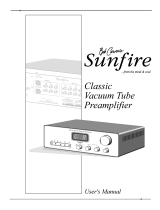
310LP MOON Series
Typically, capacitance loading adjustments will only
impact the sonic performance of a MM cartridge. We
recommend that when using a MC cartridge, you
should set the capacitance load to 0pF by placing the
supplied jumpers into sockets J6 and J24, respectively
for the left and right channels. In the event that you’re
using a MM cartridge experiment with the three (3)
available loads, selecting the load that provides the best
possible sound quality. For example, if you decided on
using the capacitance setting of 470pF, then you would
insert the supplied jumpers into sockets J8 and J26
(refer to figure 5 below).
10
Figure 5: Left and right channels
set to a 470pF capacitance load
One of the three jumper sockets for each channel must
always have a jumper inserted into it, otherwise the
310LP will not produce an output signal. As well, you
should always maintain the same capacitance setting
for both channels, otherwise sound quality may vary
between the left and right channels of your audio
system.
Equalization Curve:
The MOON 310LP Phono Preamplifier is equipped with
circuitry for two (2) different equalization curves; The
RIAA standard and the less common IEC modified curve.
The main difference is that the RIAA curve produces a
flat frequency response from 20Hz to 20kHz; The IEC
curve acts as a subsonic filter removing inaudible
infrasonic bass below 20Hz.
Figure 6: RIAA Equalization curve jumper setting
Jumper sockets J5 and J21, for the left and right
channels respectively, are used to set the 310LP’s
equalization curve. These jumpers sockets have three
pins allowing for 2 different possible positions. The
factory default position is for the RIAA curve as shown in
figure 6 where the jumper connects the lower 2 pins. To
select the IEC curve, place the jumper over the upper 2
pins as shown in figure 7.
Figure 7: IEC Equalization curve jumper setting
To determine which curve you should use, do as
follows: with the 310LP set to the RIAA curve, watch
the movement of your loudspeaker’s bass drivers – if
their motion doesn’t follow the pattern of the record
currently playing and/or you see excessive driver
movement, chances are you should use the IEC curve to
eliminate the subsonic information not present on the
record.
Gain Setting:
There are four (4) gain settings available on the MOON
310LP. They are 40dB for MM cartridges and 54dB,
60dB and 66dB for MC cartridges. However, keep in
mind that when using the balanced XLR outputs, each
of these gain levels increase by a factor of 6dB to 46dB,
60dB, 66dB and 72dB respectively (note: to keep the
circuit board labelling simple, only the single-ended
RCA gain levels are indicated).
There are three (3) jumpers sockets for each channel
that are used to adjust the gain level setting; J16, J17
and J18 for the left channel; J32, J33 and J34 for the
right channel. Each of these jumpers sockets have three
pins allowing for 2 different possible positions. As well,
there is a detailed diagram printed on the circuit board,
located just below and to the right of each of these
jumper banks, that shows the jumper positioning for
the four available gain settings (see figure 8).


















